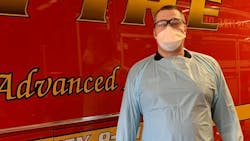FDs in Chicago Suburbs Cautious amid Pandemic
By Karen Ann Cullotta
Source Pioneer Press Newspapers, Suburban Chicago, Ill.
Editor's note: Find Firehouse.com's complete coverage of the COVID-19 pandemic here.
When the Niles Fire Department responded to a recent 911 call for service from a local nursing home, the first responders arriving at the scene were prohibited from entering the building until they had their temperatures taken.
“They were right there at the door, ready to take our temperatures to make sure we were fever-free,” Niles Fire Chief Marty Feld said. “With concerns about COVID-19, they have to take special precautions at these facilities, because much of their clientele is already compromised and they need to be proactive.”
While many area residents are heeding Gov. J.B. Pritzker’s stay-at-home order, and limiting outside activities to walks and visits to the grocery store, local firefighters and other first responders don’t have the same options.
Instead, first responders including firefighters, paramedics and police officers must dutifully show up for work and potentially risk exposure to the new coronavirus while responding to emergencies and even routine incidents involving the public.
Yet despite facing challenges, such as a scarcity of face masks needed to protect first responders and the people they are assisting from the spread of the virus, local members of the fire service say they are determined to do their part to keep their communities, and their ranks, safe from harm.
At the Glenview Fire Department, that means checking firefighters temperatures at the start and end of each shift, said Interim Fire Chief Tony DeRose.
“We’re also trying to maintain social distancing when we’re together, and we’re doing our laundry at the fire station to avoid having to take our uniforms home,” DeRose said.
In Winnetka, Fire Chief Alan Berkowsky said the COVID-19 virus has led the department to "prepare for contingencies, in case we see reductions in our staffing because of illness.”
"But we will always be available for our residents, 24/7, 365 days a year,” Berkowsky said.
With firefighters working shifts that require them to be on call for 24 hours, Berkowsky said concerns about the spread of COVID-19 has forced his crew to make adjustments to their normal routines, including ensuring that not only first responders, but the residents they are assisting, are wearing protective masks at all times.
“It doesn’t matter if we’re responding to a simple trip and fall call, the person we are assisting could actually have the virus,” Berkowsky said.
In Evanston, Fire Chief Brian Scott said firefighters are doing their "very best to protect our residents, and to protect our people in the fire department.”
“It’s imperative that we keep our firefighters healthy so they can best serve the community,” said Scott, adding that the fire department, “has taken every precaution we can to limit exposure to our people.”
“We are doing all we can to flatten the curve,” Scott added.
Glencoe Public Safety Deputy Chief Rich Weiner said his department has started handling all non-emergency reports by phone, rather than in person, to reduce the potential risk of exposure to the virus.
“The fact that the information we’re getting is constantly changing alters what we do in response," Weiner said. “But first and foremost, our main goal is protecting the public and our staff by reducing any potential spread of the virus.”
While firefighters across the U.S. are united by their determination to serve their communities during what many in fire service have described as an unprecedented public health crisis, first responders are also facing the same challenges.
One major concern is a scarcity of personal protective equipment, known as PPE, which firefighters need to protect themselves from contracting the virus, according to officials with the Washington, D.C.-based International Association of Firefighters.
“We believe that the CDC’s updated PPE recommendations for the care of patients with known or suspected COVID-19 will put firefighters and EMS personnel at risk,” Harold A. Schaitberger, general president of the IAFF wrote in a March 11 letter to the U.S. Secretary of Health and Human Services.
“The CDC recommendations state that facemasks are an acceptable alternative when the supply chain of respirators cannot meet the demand, but these recommendations are based on a controlled work environment within the healthcare setting. For fire fighters and EMS personnel, our work environment is never controlled,” Schaitberger said.
A respirator known as an N-95 or higher would provide the best protection for firefighters when it comes to caring for suspected and confirmed COVID-19 patients, IAFF spokesman Doug Stern said Wednesday.
“When the (federal government) has talked about getting any actual stockpile or funding for supplies, it’s always directed at hospitals and doctors’ offices, and very rarely for firefighters, even though we are the first link in the public health chain,” Stern said.
Back in Niles, Fire Chief Marty Feld echoed Stern’s concerns about needed PPE equipment to keep his first responders safe.
“The (respirators) are much more scarce right now, and it’s going to take a while to get them replenished,” Feld said, adding: “In 33 years, I’ve never experienced anything like this, and it’s new to every one of us. But we’re all remaining hopeful, and trying to stay positive."
———
©2020 Pioneer Press Newspapers (Suburban Chicago, Ill.)
Visit Pioneer Press Newspapers (Suburban Chicago, Ill.) at www.chicagotribune.com/suburbs
Distributed by Tribune Content Agency, LLC.






